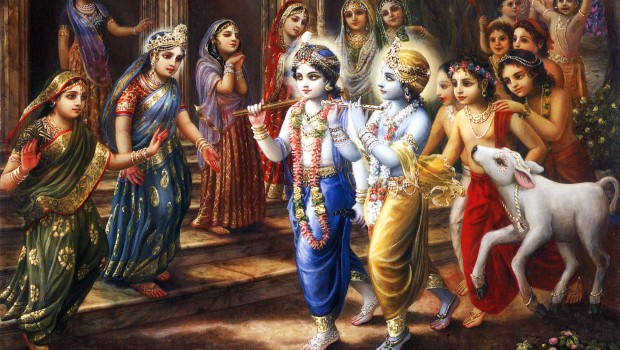Throughway to Happiness
Every one of us is searching after happiness, but we do not know what real happiness is. We see so much advertised about happiness, but practically speaking we see so few happy people. This is because so few people know that the platform of real happiness is beyond temporary things. It is this real happiness that is described in Bhagavad-gita by Lord Krsna to Arjuna.
Happiness is generally perceived through our senses. A stone, for instance, has no senses and cannot perceive happiness and distress. Developed consciousness can perceive happiness and distress more intensely than undeveloped consciousness. Trees have consciousness, but it is not developed. Trees may stand for a long time in all kinds of weather, but they have no way of perceiving miseries. If a human being were asked to stand like a tree for only three days or even less, he would not be able to tolerate it. The conclusion is that every living being feels happiness or distress according to the degree of development of his consciousness.
The happiness that we are experiencing in the material world is not real happiness. If one asks a tree, “Are you feeling happy?” the tree, if it could, might say,”Yes, I am happy, standing here all year. I’m enjoying the wind and snowfall very much, etc.” This may be enjoyed by the tree, but for the human being it is a very low standard of enjoyment. There are different kinds and grades of living entities, and their conceptions and perceptions of happiness are also of all different types and grades. Although one animal may see that another animal is being slaughtered, he will go right on chewing grass, for he has no knowledge to understand that he may be next. He is thinking that he is happy, but at the next moment he may be slaughtered.
In this way there are different degrees of happiness. Yet of all of them, what is the highest happiness? Sri Krsna tells Arjuna:
sukham atyantikam yat tad
buddhi-grahyam atindriyam
vetti yatra na caivayam
sthitas calati tattvatah
“In that joyous state (samadhi), one is situated in boundless transcendental happiness and enjoys himself through transcendental senses. Established thus, one never departs from the truth.” (Bg. 6.21)
Buddhi means intelligence; one has to be intelligent if he wants to enjoy. Animals do not have really developed intelligence and so cannot enjoy life as a human being can. The hands, the nose, the eyes, the other sense organs and all the bodily parts may be present on a dead man, but he cannot enjoy. Why not? The enjoying energy, the spiritual spark, has left, and therefore the body has no power. If one looks further into the matter with a little intelligence, he can understand that it was not the body that was enjoying at all but the small spiritual spark that was within. Although one may think that he is enjoying by the bodily sense organs, the real enjoyer is that spiritual spark. That spark always has the potency of enjoyment, but it is not always manifest due to being covered by the material tabernacle. Although we may not be aware of it, it is not possible for the body to experience enjoyment without the presence of this spiritual spark. If a man is offered the dead body of a beautiful woman, will he accept it? No, because the spiritual spark has moved out of the body. Not only was it enjoying within the body, but it was maintaining the body. When that spark leaves, the body simply deteriorates.
It follows that if the spirit is enjoying, it must have its senses also, otherwise how can it enjoy? The Vedas confirm that the spirit soul, although atomic in size, is the actual enjoying agent. It is not possible to measure the soul, but that is not to say that it is without measurement. An object may seem to us to be no bigger than a point and may seem to have no length or width, but when we perceive it under a microscope we can see that it has both length and width. Similarly, the soul also has its dimensions, but we cannot perceive them. When we buy a suit or dress, it is made to fit the body. The spiritual spark must have form, otherwise how is it the material body has grown to accommodate it? The conclusion is that the spiritual spark is not impersonal. It is an actual person. God is an actual person, and the spiritual spark, being a fragmental part of Him, is also a person. If the father has personality and individuality, the son also has them; and if the son has them, we can conclude that the father has them. So how can we, as sons of God, assert our personality and individuality and at the same time deny them to our Father, the Supreme Lord?
Atindriyam means that we have to transcend these material senses before we can appreciate real happiness. Ramante yogino ‘nante satyananda-cid-atmani: the yogis who are aspiring after spiritual life are also tasting enjoyment by focusing on the Supersoul within. If there is no pleasure, if there is no enjoyment, then what is the point of going to so much trouble to control the senses? What kind of pleasure are the yogis relishing if they are taking so much trouble? That pleasure is ananta–endless. How is this? The spirit soul is eternal, and the Supreme Lord is eternal; therefore reciprocation of their loving exchanges is eternal. One who is actually intelligent will refrain from the flickering sensual enjoyment of this material body and fix his enjoyment in spiritual life. His participation in spiritual life with the Supreme Lord is called rasa-lila.
We have often heard of Krsna’s rasa-lila with the cowherd girls in Vrndavana. That is not like ordinary exchanges that take place between these material bodies. Rather it is an exchange of feelings through spiritual bodies. One has to be somewhat intelligent to understand this, for a foolish man, who cannot understand what real happiness is, seeks happiness in this material world. In India there is the story of a man who did not know what sugarcane was and was told that it was very sweet to chew. “Oh, what does it look like?” he asked. “It looks just like a bamboo rod,” someone said. So the foolish man began to chew all kinds of bamboo rods. How can he begin to experience the sweetness of sugarcane? Similarly, we are trying to get happiness and pleasure, but we are trying for them by chewing this material body; therefore there is no happiness and no pleasure. For the time being there may be some little feeling of pleasure, but that is not actual pleasure, for it is temporary. It is like a show of lightning which we may see flashing in the sky that may momentarily seem like lightning, but the real lightning is beyond that. Because a person does not really know what happiness is, he deviates from real happiness.
The process for establishing oneself in real happiness is this process of Krsna consciousness. By Krsna consciousness we can gradually develop our real intelligence and naturally enjoy relishing spiritual happiness as we make spiritual progress. As we begin to relish spiritual happiness, we proportionately abandon material happiness. As we make progress in understanding the Absolute Truth, we naturally become detached from this false happiness. If somehow or other one is promoted to that stage of Krsna consciousness, what is the result?
yam labdhva caparam labham
manyate nadhikam tatah
yasmin sthito na duhkhena
gurunapi vicalyate
“Upon gaining this, he thinks there is no greater gain. Being situated in such a position, one is never shaken, even in the midst of greatest difficulty.” (Bg. 6.22)
When one attains that stage, other achievements appear insignificant. In this material world we are trying to achieve so many things–riches, women, fame, beauty, knowledge, etc.–but as soon as we are situated in Krsna consciousness we think, “Oh, no achievement is better than this.” Krsna consciousness is so potent that a little taste can save one from the greatest danger. As one begins to relish the taste of Krsna consciousness, he begins to see other so-called enjoyments and attainments as flat and tasteless. And if one is situated firmly in Krsna consciousness, the greatest danger cannot disturb him. There are so many dangers in life because the material world is a place of danger. We tend to close our eyes to this, and because we are foolish we try to adjust to these dangers. We may have many dangerous moments in our lives, but if we are training ourselves in Krsna consciousness and preparing ourselves to go home, back to Godhead, we will not care for them. Our attitude will then be: “Dangers come and go–so let them happen.” It is very difficult to make this kind of adjustment as long as one is on the materialistic platform and is identifying with the gross body, which is composed of perishable elements. But the more one advances in Krsna consciousness, the more he becomes free from bodily designations and this material entanglement.
In Srimad-Bhagavatam the material world is compared to a great ocean. Within this material universe there are millions and billions of planets floating in space, and we can just imagine how many Atlantic and Pacific Oceans are there. In fact, the whole material universe is likened to a great ocean of misery, an ocean of birth and death. In order to cross this great ocean of nescience, a strong boat is needed, and that strong boat is the lotus feet of Krsna. We should immediately get aboard that boat. We should not hesitate, thinking that Krsna’s feet are very small. The whole universe is simply resting on His leg. For one who takes shelter of His feet, it is said that the material universe is no more significant than a puddle of water found in the impression of a calf’s hoofprint. There is certainly no difficulty in crossing over such a small puddle.
tam vidyad duhkha-samyoga-
viyogam yoga-samjnitam
“This indeed is actual freedom from all miseries arising from material contact.” (Bg. 6.23)
We are entangled in this material world due to uncontrolled senses. The yoga process is meant to control these senses. If somehow we can manage to control the senses, we can turn our face to actual spiritual happiness and make our lives successful.
sa niscayena yoktavyo
yogo ‘nirvinna-cetasa
sankalpa-prabhavan kamams
tyaktva sarvan asesatah
manasaivendriya-gramam
viniyamya samantatah
sanaih sanair uparamed
buddhya dhrti-grhitaya
atma-samstham manah krtva
na kincid api cintayet
yato yato niscalati
manas cancalam asthiram
tatas tato niyamyaitad
atmany eva vasam nayet
“One should engage oneself in the practice of yoga with undeviating determination and faith. One should abandon, without exception, all material desires born of false ego and thus control all the senses on all sides by the mind. Gradually, step by step, with full conviction, one should become situated in trance by means of intelligence, and thus the mind should be fixed on the Self alone and should think of nothing else. From whatever and wherever the mind wanders due to its flickering and unsteady nature, one must certainly withdraw it and bring it back under the control of the Self.” (Bg. 6.24-26)
The mind is always disturbed. It is going sometimes this way and sometimes that way. By yoga practice we literally drag the mind to Krsna consciousness. The mind strays from Krsna consciousness to so many exterior objects because from time immemorial, life after life, that has been our practice. Due to this, there may be great difficulty in the beginning when one tries to fix his mind in Krsna consciousness, but these difficulties can all be overcome.
It is because the mind is agitated and not fixed on Krsna that it goes from one thought to another. For instance, when we are engaged in work, memories of events that happened ten, twenty, thirty or forty years ago may suddenly come to our mind for no apparent reason. These thoughts come from our subconscious, and because they are always rising, the mind is always agitated. If we agitate a lake or a pond, all the mud from the bottom comes to the surface. Similarly, when the mind is agitated so many thoughts arise from the subconscious that have been stored there over the years. If we do not disturb a pond, the mud will settle to the bottom. This yoga process is the means to quiet the mind and allow all these thoughts to settle. For this reason there are so many rules and regulations to follow in order to keep the mind from becoming agitated. If we follow the rules and regulations, gradually the mind will come under control. There are so many don’t’s and so many do’s, and if one is serious about training the mind, he has to follow them. If he acts whimsically, what is the possibility of the mind being controlled? When the mind is finally trained to the point where it will think of nothing but Krsna, it will attain peace and will become very tranquil.
prasanta-manasam hy enam
yoginam sukham uttamam
upaiti santa-rajasam
brahma-bhutam akalmasam
“The yogi whose mind is fixed on Me verily attains the highest happiness. By virtue of his identity with Brahman, he is liberated; his mind is peaceful, his passions are quieted, and he is freed from sin.” (Bg. 6.27)
The mind is always concocting objects for happiness. I am always thinking, “This will make me happy,” or “That will make me happy. Happiness is here. Happiness is there.” In this way the mind is taking us anywhere and everywhere. It is as though we are riding on a chariot behind an unbridled horse. We have no power over where we are going but can only sit in horror and watch helplessly. As soon as the mind is engaged in the Krsna consciousness process–specifically by chanting Hare Krsna, Hare Krsna, Krsna Krsna, Hare Hare. Hare Rama, Hare Rama, Rama Rama, Hare Hare–then the wild horses of the mind will gradually come under our control. We must engage in Krsna’s service every moment of our lives in order to keep the restless and turbulent mind from dragging us from one object to another in a vain search for happiness in the temporary material world.
yunjann evam sadatmanam
yogi vigata-kalmasah
sukhe na brahma-samsparsam
atyantam sukham asnute
“Steady in the Self, being freed from all material contamination, the yogi achieves the highest perfectional stage of happiness in touch with the supreme consciousness.” (Bg. 6.28)
Krsna serves as a patron for one who is devoted to Him. When one is in difficulty, his patron saves him. As stated in Bhagavad-gita, Krsna is the real friend of every living entity, and we have to revive our friendship with Him. The method for reviving this friendship is the process of Krsna consciousness. By practice of Krsna consciousness, mundane passionate hankering will come to a stop. This passionate hankering keeps us divorced from Krsna. Krsna is within us and is waiting for us to turn to Him, but we are too busy passionately eating the fruits of the tree of material desire. This passionate compulsion to enjoy these fruits must stop, and we must situate ourselves in our real identity as Brahman–pure spirit.
(From On the Way to Krishna by His Divine Grace A.C. Bhaktivedanta Swami Prabhupada)















Extremely brilliant and transcendental article… No words to describe the beauty… Simply nectar!!!! Millions of thanks Prabhuji for enlightening us with this article.. Hare Krishna.. Haribol!! Jai Srila PRabhupada!!!
Radhey radhey …
radhey Krishna
Thank You for posting this article…many times I keep thinking what really makes me happy and I keep searching for happiness in the material world, but I was always disappointed because I never found it…once again thanks for the article, it really opened my eyes…HARE KRISHNA!
the video display right side really great.
i thank every one who worked for this
very nice one
Thanks for the daily article/blog post.This one was a great post.Please also throw light on how Krishna wants us to meditate.